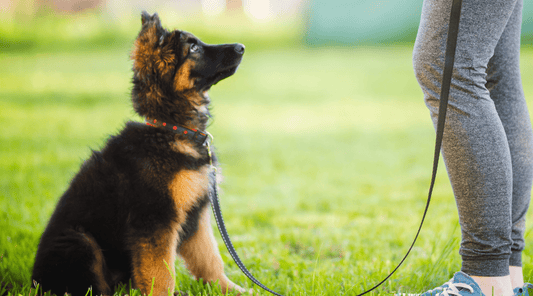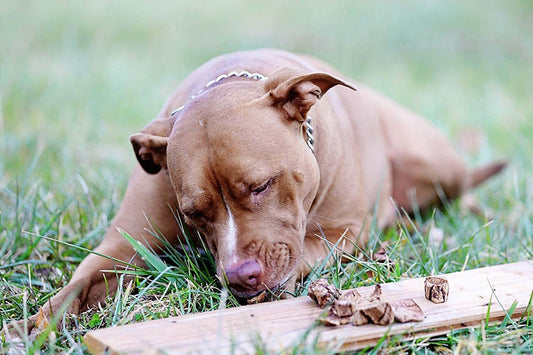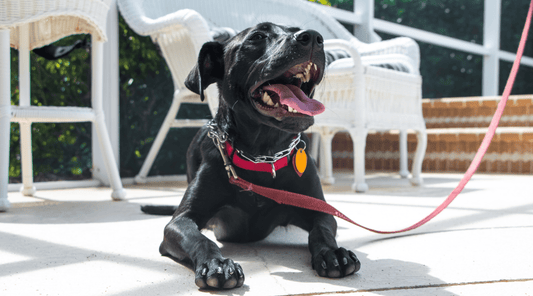Teething Puppy: Her Couch Will Never Be the Same
Dawn Miller May 15, 20255 Minute ReadIf you’ve ever come home to find your throw pillow shredded like mozzarella or the corner of your coffee table looking a little more… rustic… then congratulations—you probably have a teething puppy.
And before you ask—yes, I’ve been there a few times. While my terrier Pixie and lab mix Bruno are rescues, we certainly experienced the joys and trials of puppy parenting while my college kids were still young.
My neighbor, Clarissa, recently faced this dilemma. Before she knew it, her beagle, Luz, had chewed through the corner of a fashion magazine and was headed for the pedestal sofa to commence making a meal of the carved wooden leg.
She drew the teething tornado up into her arms and started looking for answers—what to expect, how long teething lasts, and the best bones for puppies to chew.
When Do Puppies Start Teething?
Most puppies start teething around 3 weeks of age. You usually don’t feel it until they’re closer to 12 weeks old—but they can. Those teeth are working their way up through the tender skin—not exactly comfortable.
At this stage, putting pressure on the gums provides temporary relief. So, puppies gnaw on anything they can get into their mouth.
Here's the breakdown on teeth breaking in:
- Weeks 3–6: Baby teeth (aka “milk teeth”) begin to come in. These are soft and fragile.
- Weeks 12–16: Baby teeth start to fall out, and adult teeth push through.
- By 6 months: Most puppies have a full set of adult teeth (42 total!)
During that 3–6 month window (12-24 weeks), your puppy may seem like a mix between a toddler and a wood chipper. It’s normal. But it’s also your job to keep them comfortable—and to make sure your belongings survive the process.
Signs of a Teething Puppy
Aside from turning into a furniture demolition expert overnight, here are some common signs your pup is teething:
- Constant puppy biting and chewing (furniture, fingers, shoelaces—nothing is safe)
- Drooling more than usual
- Red, swollen gums
- Eating strange things like rocks.
- Whining or fussiness
- Loss of appetite or slow eating
- Occasionally, finding a tiny tooth on the floor (yes, it’s a thing!)
When I was around 6 years old, I was playing tug-of-war with my puppy and an old T-shirt. I was devastated to see several teeth pop out onto the floor. I thought I'd pulled his teeth out, and my mom had to explain to my boohooing 6-year-old that puppy baby teeth fall out, too!
Of course, my next question was if the tooth fairy also brings puppies a quarter for every tooth.
When you have a teething puppy, it's important to provide chewable treats and toys to ease the symptoms.
What Dog Teething Treats Should I Avoid?
Some dog bones are too soft or porous for puppies. New adult teeth can get caught in them and pull out while the gums are extra sensitive. Used bone broth bones and chicken bones are examples of soft bones. Dairy cow bones are often porous because they come from older lady cows who have usually begun to develop osteoporosis.
On the other hand, if a dog bone, treat, or toy is too hard, it can break those soft baby teeth before they're ready to come out. This could hinder a puppy's transition to solid food.
Raw dog bones may seem all-natural. But they are too hard for a puppy, not to mention you're exposing a puppy to raw meat pathogens that their underdeveloped immune systems may not be ready for.
At the same time, some dog bones and treats have added sugar, which can lead to tooth decay. And artificial colors and flavors that have been linked to cancer and mental health concerns in animal studies.
What Bones and Treats Are Safe for a Teething Puppy?
Look for single-ingredient dog treats and dog bones that have been prepared to a safe density for puppies using a slow and low roasting method. This keeps the bone firm enough to withstand chewing, but not so brittle that it splinters or breaks baby teeth.
I choose grass-fed beef bones from K9 Connoisseur because they are all-natural, slow-roasted beef marrow bones with no potentially harmful ingredients. Why grass-fed? Because grass-fed beef has 2.5X the omega-3 of conventional beef. Puppies need healthy fats like omega-3s to support brain development, learning, and overall dog health.
Puppies also haven't learned how to manage their bite force. So, it's important not to go for a weak bone that can't stand up to aggressive chewing. Natural bones for puppies have what it takes to get through puppyhood.
Best Bones for Puppies to Chew
When it comes to natural bones for puppies, you can't go wrong with single-ingredient grass-fed beef bones. But the size of the bone also matters. If you give a dog a bone that's too small, they might try to swallow it and choke.
If the bone for your puppy is too big, it's not a safety hazard. But it will be harder for them to get the teething benefits if they can't get their jaw around it. That's why I absolutely love that K9 Connoisseur categorizes its bones by dog size.
Best Dog Bone for Small Puppies and Adults
If you have a small puppy, try gentle beef bones like riblets. These toy-dog-sized bones contain nutritious beef marrow and have curved sides that make it easier for even tiny dogs to enjoy.
Best Dog Bone for Puppy When Larger
Some puppies are big from the start or grow very quickly, so they need a dog intended for a medium-sized adult dog. I like a gentle beef bone, such as crown knuckles, for these oversized babies. These all-natural beef bones have knobs that dogs can chew on but those knobs also make the bone too big for a large puppy to swallow.
If you have a large puppy, know that they grow fast. So, you may be progressing to large dog bones as early as 6-12 months.
Also, be sure to try trachea chews for both large and small puppies. They are made of collagen and glucosamine-rich cartilage, which is excellent for helping put together healthy bones and joints. All-natural beef trachea also comes in two sizes, for large and small puppies.
Got a new puppy? It's best to start training them early while they're the most eager to learn. Be sure to check out the 7-day dog training challenge to find tips, tricks, and opportunities to earn rewards and discounts for training your dogs.
Available On:
Disclosure: This article may contain affiliate links, which means we may earn a small commission if you make a purchase through these links—at no extra cost to you. We only recommend products we trust and believe will benefit you and your K9.






